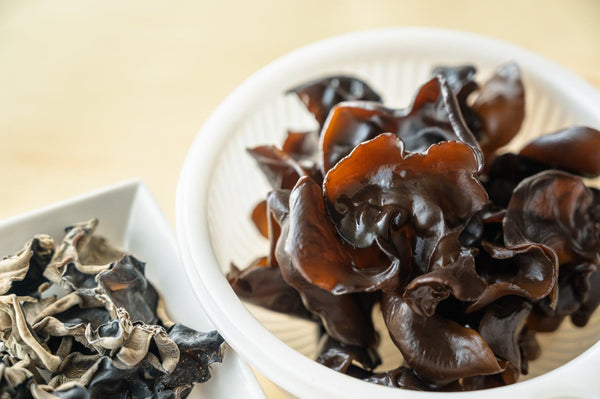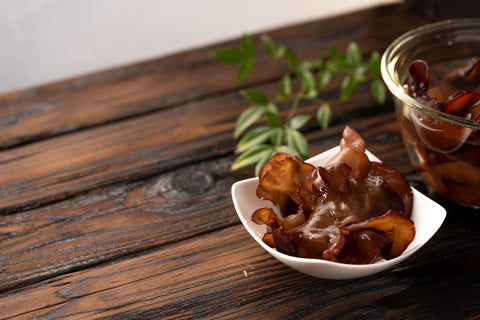
Jump to:
If you have ever eaten ramen noodles, you may well have come across Kikurage cut into strips and used as a topping. Called “wood ear mushroom” in English (which is literally a translation of the characters “木耳” in Japanese), due to the fact that it resembles a dark brown ear, Kikurage is an edible type of Japanese mushroom that grows wild in Japan and is popular in many Japanese and Asian dishes.
In addition to China, where they originated, and Japan, Kikurage are also commonly eaten in Vietnam, Tibet, and the Philippines. Due to their health benefits, discussed later, interest in them is now at a global level.
In this blog post, we shall look at the history of Kikurage, how it is harvested, and where the main areas of production are in Japan. We will then look at the nutritional and health benefits of Kikurage, how to prepare it, look at some popular Japanese dishes that use it, and round off by looking at some options for purchasing Kikurage.
History Of Kikurage
In nature, Kikurage grows in clusters on dead or fallen broadleaf trees such as zelkova, elderberry, mulberry, silverberry, and elm, and its presence has been confirmed worldwide. Although, nowadays, its use as a food is recognized around the world, until recently Kikurage was only used in the West, predominantly by Native American and European herbalists as a medical fungus, such as a poultice to treat eye irritation and as a means of relieving throat problems.
In Asian countries, such as Japan, China, and Korea, however, its edible qualities have long been recognized. Works of literature in China suggest that it has been eaten there for at least 1500 years. As there is a reference to it in a Chinese-to-Japanese dictionary compiled in the middle of the Heian period, around the tenth century, and it was then mentioned in various other documents, we can deduce that it was probably brought to Japan around that time.
How Are Kikurage Mushrooms Harvested?

We have already discussed how Kikurage mushrooms grow in the wild, but how are they harvested? We shall describe the process below, but if you are planning to pick your own, make sure you know what you are picking. Certain types of mushrooms can be highly toxic and potentially lethal to eat.
Due to the way they grow, harvesting Kikurage is necessarily performed manually. Harvesting should be done by holding the root of the Kikurage and, using a cutter knife or scissors, cut 2-3 mm above the root. Then gouge into the fungus bed slightly and remove the root. If the root remains, it will rot. Scrape off any remaining root with a spoon. If the Kikurage mushrooms are growing in clumps and only some of the clumps are of significant size, harvest only the large ones and leave the smaller ones for later. After removing one clump, be sure to remove its root. If harvested properly, another Kikurage sprout will grow from the same spot. You can harvest about 50-100 grams at a time.
Main Areas Of Production In Japan?
Although a large amount of Kikurage is consumed in Japan, especially due to the popularity of ramen, currently 97% of the Kikurage distributed in Japan is dried Kikurage imported from China.
The top-ranked prefectures in terms of production in Japan are Miyagi, Gifu, and Tottori, each with approximately 10% of the domestic market. A total of approximately 3,132 tons is harvested in Japan annually, which gives you some idea of the huge scale of Chinese imports.
Are Kikurage Mushrooms Good For You?

The answer to this question is an unequivocal “Yes!!”
In addition to having negligible calorie content, Kikurage is rich in many of the nutrients that you need to consume in your daily diet.
The following is an explanation of the nutrients that it is particularly rich in and its particular benefits for women, children, and the elderly.
Calcium
Dried Kikurage is rich in calcium, a major nutrient required for good bones and teeth. Its content is one of the highest among all mushrooms. From childhood, when bones are growing, to adults who want to prevent osteoporosis, Kikurage is a good source of calcium.
Vitamin D
Kikurage is high in Vitamin D, which when activated in the body helps to boost the immune system and promotes calcium absorption.
Iron
Dried Kikurage contains high levels of non-heme iron. Non-heme iron is an iron component that is essential for the synthesis of hemoglobin, the main component of red blood cells, and helps prevent anemia and relieve dizziness, shortness of breath, and fatigue.
β-glucan
β-glucan is a type of insoluble dietary fiber that is abundant in the cell walls of mushrooms. β-glucan suppresses the absorption of lipids and carbohydrates and regulates the intestinal environment. It can also be expected to lower cholesterol levels in the blood by stimulating the elimination of bile acids and to enhance the body’s immune system.
Potassium
Lastly, Kikurage mushrooms are also high in potassium, an essential mineral. Potassium is effective in preventing swelling and high blood pressure because it helps eliminate excessive sodium intake from the body through urine.
How Do You Prepare Kikurage
If you buy Kikurage in its most common dried form, you will first need to rehydrate them. This can be simply soaking them in water, or even overnight. If you use fresh Kikurage you can, of course, omit this step. Once this is done, just cut into the requisite sizes and cook in the appropriate way for the dish you are making.
Popular Dishes Including Kikurage
We have already mentioned the popularity of Kikurage as a topping for ramen, but it is also used in a wide range of other dishes. The following are some popular dishes that include Kikurage.
Oden

Oden is a very popular dish in the winter in Japan. Not only is it eaten widely in the family home, but you can also find dedicated Oden restaurants, and even find it bubbling away near the cash registers of convenience stores where you can buy it piece by piece. A popular type of Oden is Ganmodoki, which is a deep-fried tofu fritter that also contains vegetables, one of which is Kikurage. For more information on Oden, check out this article.
Chinese stir-fried pork and Kikurage with egg

This combination of fluffy egg and the crunchy texture of Kikurage makes for a delicious dish. This is a particularly useful dish for using up any leftover Kikurage in your kitchen and is a great accompaniment to white rice.
Kikurage Tsukudani

Tsukudani is a traditional Japanese preserved food that uses small fish, shellfish, or seaweed cooked with soy sauce and a little bit of sugar. Kikurage is also delicious as Tsukudani. The crunchy texture of kikurage is pleasant and addictive, and not only goes well with rice but can also be enjoyed as a tsumami snack with alcohol.
Where Can I Purchase Kikurage Mushrooms?
Kikurage can be purchased in two forms: fresh or dried. Dried Kikurage can be found in nearly all supermarkets in the dried food section. Fresh Kikurage may be somewhat harder to find and will generally not be available in the produce section of smaller supermarkets.
Your best bet if you are looking for fresh Kikurage is a larger supermarket chain with a richly stocked vegetable section. You also might like to try the so-called “Michi-no-Eki”. Michi-no-Eki is a system of government-designated rest stops launched in the mid-1990s with the intention of making life easier for those heading out on the open road. They often have a good supply of local produce, so “Michi-no-eki” in prefectures that produce Kikurage may be worth checking out.
Dried Kikurage, however, will normally be sufficient for most people’s needs, and you can purchase dried Kikurage mushrooms from Mori Sangyo, a Japanese mushroom producer from Kyushu, noted for its high-quality mushrooms online here in a 100 g pack. If you would like to try a smaller pack first, then this 10 g pack from Shoan may be worth a look too. They also have the product in sliced form here.
If you would like more general information about Japanese mushrooms, this article will be a good place to start.
Kikurage -The Healthy And Versatile Wild Japanese Mushroom

As described above, Kikurage is widely eaten, particularly as a topping for ramen noodles, a wildly popular dish in Japan. This is not its only application, however, and its crunchy texture makes it a popular ingredient in a wide range of other dishes.
Virtually calorie-free, it absorbs water well and is highly satiating, making it perfect for people looking to lose weight. Its host of other nutritional benefits means that it is a truly healthy option for everyone. Although primarily popular in Asian cuisine, these health benefits have led to it being recognized as a health food in Western countries, where previously it was only used as a type of herbal medicine.
Have you tried Kikurage yet? Let us know what you think of it in the comments.


0 comments